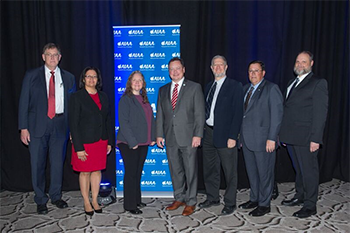Big Data’s Power Starting to Reach Potential Written 9 January 2018
Panelists: Moderator Joseph Morrison, associate project manager, Transformational Tools and Technologies, NASA’s Langley Research Center; Jandria Alexander, principal, Booz Allen Hamilton Inc.; David Keyes, director, Extreme Computing Research Center, King Abdullah University of Science & Technology; Pamela Kobryn, principal aerospace engineer, Structures Technology Branch, Aerospace Vehicles Division, Aerospace Systems Directorate, Air Force Research Laboratory; Dimitri Mavris, director, Aerospace Systems Design Laboratory, Georgia Institute of Technology; Mark Valentine, Department of Defense Strategic Initiatives Group, Microsoft
by Michele McDonald, AIAA Communications Manager

The aerospace industry can be a leader in how best to apply big data to real-world critical missions, speakers discussed in a series of presentations Jan. 9 during the “Data, Data Everywhere ... the Power & Potential” session at the 2018 AIAA SciTech Forum in Kissimmee, Florida
The influx of digital data is changing everything from improving how we buy cars to space exploration. For example, Pamela Kobryn, a principal aerospace engineer with the Aerospace Systems Directorate at the Air Force Research Laboratory, said digital twins — digital counterparts to physical things — could change how we buy and maintain cars.
Your digital twin would know your driving habits, including the routes you take and how much you hit the brakes, she said, explaining the information would be “personalized to how you are going to drive that vehicle.”
Kobryn explained automakers would have simulations to match driving habits and requirements with vehicles and that you’d know how your new car would handle, how much gas it would use and future maintenance costs.
“Now imagine if that simulation capability was free, easy to use and access, and readily available — it would be pretty cool,” she said.
But the journey doesn’t stop there. Your new car would have its digital counterpart continually updated about maintenance needs and could predict possible breakdowns during trips, Korbyn said, adding that when it’s time to buy a new car, the digital twin could inform the timing of that decision, too.
The same concept of digital twins can be applied to aircraft, spacecraft and other complex systems, Korbyn said.
Big data also is changing digital assistants, said Mark Valentine, with the Department of Defense Strategic Initiatives Group at Microsoft.
“There are millions of decision points, and the data is overwhelming, so it sounds to me like we need some help,” he said.
And Valentine said we’re already familiar with the perfect digital assistant.
“I think George Lucas gave us the best blueprint for a digital assistant back in 1975, and his name was R2-D2,” Valentine said. “R2-D2 could do almost everything.”
He said future assistants will take action.
“Much like Luke (Skywalker) would tell R2 to go do something and R2 would go do it,” Valentine said.
Digital assistants are drawing data from sensors, context and our actions.
“Our assistants now know me — they know us — our preferences,” Valentine said. “And not just what we say we like, but they learn from our actions. There’s a complete difference between what we say we like and what we actually like. Digital assistants now know my context because of the proliferation of sensors ... now the digital assistant can anticipate what I need to know in the future.”
This deep knowledge of our lives leaves us vulnerable when paired with cybersecurity concerns and questioning if we can trust the data, said Jandria Alexander, principal at Booz Allen Hamilton.
She said computer systems constantly are under attack, and the attackers don’t have to be sophisticated to cause damage. Legacy systems are easy targets, Alexander said, adding that newer complex systems are connected to these vulnerable systems.
No system is safe from attack, she said, explaining that the new approach is to be resilient and continue to operate through attacks. Alexander said big data is giving us some detailed answers about how to build resiliency against cyberattacks into the systems.
But planning for cybersecurity becomes thornier when it takes decades to build a spacecraft while technology keeps evolving.
“What we’re fielding has to be sound and has to protect from threats we can’t even predict,” Alexander said. “We don’t even know what those threats are. But the good news is if we build these in an architecturally sound fashion, we can actually prevent classes of attacks.”
